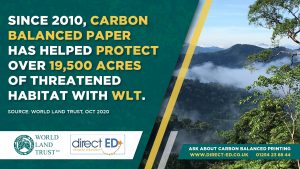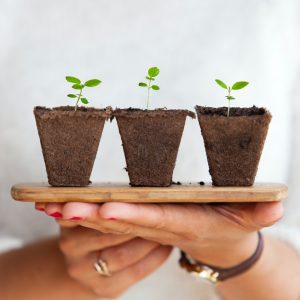
Direct-ED Becomes Carbon Balanced Printer
In January 2022, Direct-ED was officially confirmed as a Carbon Balanced Printer with the World Land Trust. This is amazing news that the team have




Sustainability is the buzzword of the 21st century and seems to have snuck into everything from fashion lines to supermarkets, our favourite television shows and even the way we choose to travel and experience other cultures and places. As such, the way we teach and encourage young people to understand the importance of sustainable living is key – not just in school but at home as well.
The very best learning comes when schools partner up with parents to deliver consistent messaging and touch on the importance of life skills and lessons outside as well as inside the classroom. In this article we will be sharing some of the most popular sustainability projects and eco projects for kids to try at home, which can be transferred into the classroom and used to support a broad understanding of the importance of our place in the natural world.
What is a sustainable project?
A sustainable project is one which touches on the core focus points of a harmonious relationship between humans and our environment. This doesn’t just mean pollution and climate change, but also the way we interact as a community, the way we support different lifestyles, the way we act towards others, and the way we meet the needs of our present without destroying the future for the next generation and beyond.
In short, a sustainable project for kids is one which introduces them to these issues and fundamental life lessons and encourages them to make small changes and take small steps towards maintaining the balance between us and our natural world – for the benefit of the future.
Sustainability is very much a forward-thinking area of focus and can be supported with a series of initiatives and viewpoints.
Why home-based sustainable projects are so vital
Eco projects for kids to get involved in at home allow them to see how these issues transition outside of the classroom and into the real world. The projects outlined in the following guide are all examples of things that kids can do with their parents and other family and friends to make small changes to the way they approach the natural world, in an effort to connect with and understand the importance of a harmonious balance across every area of life.
Sustainable Projects at Home: A Guide
The following are all ideas that can introduce and educate kids on certain issues to do with sustainability and the natural world, and they can all be completed and trialled at home!
For Plants
Planting trees, flowers for pollinators, vegetables for self-sufficient production, and shrubs and hedges for wildlife are all steps you can take to make your garden eco-friendly and to introduce your kids to the small steps they can take to help nature.
If you don’t have a garden or are limited on space, consider the value of a plant wall in an urban environment, hanging baskets and potted plants, or even taking your kids to the local park to explore and immerse themselves in nature.
For Insects
Building an insect hotel is the kind of thing that many of us would have learnt how to do through Blue Peter – and it’s a skill we can pass on to our kids today to get them excited about insects and creating somewhere for them to live. Your insect hotel can be as complex or as simple as you like, with plenty of kits available online – alternatively a large trunk of wood and a power drill will create the same effect for the insects in your garden.
Pollinators will also be looking for the right plants and flowers to support their activity so having a few of these dotted around your insect hotel will do wonders for the bees in your garden or outside space. In the heat of summer, another thing you can do for bees in particular is leave out a small dish of sugar water to give them somewhere safe to land and refuel.
For Wildlife
Different outdoor spaces attract different wildlife and knowing and identifying what that wildlife looks like is a fun way of getting kids engaged and allowing them to feel at one with nature. If you have the space, set up a night camera and watch the footage back with your kits as you try to identify what’s coming into your garden at night – e.g., hedgehogs and badgers. You can then lay out food and water for those creatures – particularly in summer and winter when food and drink is harder to come by.
Walk More
This is one to start integrating into your weekends and holidays, with various challenges making the idea of walking more interactive and fun. The more you can walk rather than drive, the lower your emissions will be into the atmosphere – something that it’s great to teach kids from a very young age.
This can be supplemented with challenges held at school, encouraging kids to track their steps every day and partake in full-class competitions about who can walk the most in a week and a month.
Trial a Meat Free Day every Week
Not necessarily one for vegetarian families, but if you diet is always built around meat then it can be fun to explore other recipes which focus more on vegetables and the kinds of ingredients which are considered more sustainable and kinder to the planet. If you can grow some of them yourself – even better!
The Takeaway
The best sustainability drives, and the best way to help our kids grow up to be more eco-friendly, is to combine forces and introduce sustainable concepts both in school and at home. By trialling some of these projects at home, kids will be encouraged to understand the natural world and sustainability as something that is important outside the classroom, and as something that is part of their everyday life at home as well as at school.


In January 2022, Direct-ED was officially confirmed as a Carbon Balanced Printer with the World Land Trust. This is amazing news that the team have

If you’re wondering how to home school and are looking for some tips, the first thing to understand is that home learning isn’t just about

Sustainability is the buzzword of the 21st century and seems to have snuck into everything from fashion lines to supermarkets, our favourite television shows and




